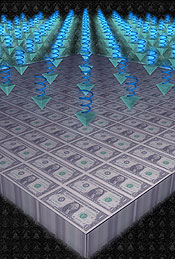Researchers at Northwestern University have introduced a novel technique to create rapid prototypes of nanoscale structures and devices using a print head that is so cost-effective that it can be even disposed after process completion.
Hard-tip, soft-spring lithography (HSL) integrates the ease of implementation and cost-effectiveness of polymer pen lithography with the high-resolution of scanning probe lithography.
 Northwestern researchers have developed an innovative method for printing nanostructures using hard, sharp “pen” tips that float on soft polymer springs. The technique quickly and inexpensively produces patterns of high quality and with high resolution and density
Northwestern researchers have developed an innovative method for printing nanostructures using hard, sharp “pen” tips that float on soft polymer springs. The technique quickly and inexpensively produces patterns of high quality and with high resolution and density
Nano-lithographic and micro-lithography techniques are utilized to create surface architectures and develop patterns of materials on a miniature-scale. Although scanning probe lithography, featuring precise registration and high-resolution, is being used for developing nanostructures, it is difficult to produce several copies of a structure or device at economical rates.
HSL utilizes a soft polymer base that holds sharp silicon tips as a print head. The spring polymer base enables every single tip to uniformly contact the material surface without the use of cantilevers. Basically, hard tips are made to float on soft spring polymers, enabling energy or material to be transferred to a surface.
HSL provides a cost-effective technique that rapidly creates high-resolution, high-density, and high-quality patterns. The cost of fabricating prototype arrays comprising 4,750 tips is equivalent to the cost of fabricating one cantilever-based tip, stated Mirkin, senior author of the research paper published in journal Nature.
Mirkin along with his team aligned 4,750 ultra-sharp silicon tips on an area measuring 1cm2. Patterns with below 50 nm resolution can be produced by controlling the time the tip contacts the substrate. They created patterns by “writing” using molecules and demonstrated that when the tips are made to push against the surface, the base compresses. This indicates that the tips are contacting the surface and writing is being performed. Additionally, the researchers showed the usage of HSL in transferring electrical and mechanical energy to a substrate.
HSL can be utilized in areas of pharmaceuticals for sorting drug candidates, in electronics for developing electronic circuits, and medical diagnostics for gene chips and for identification of biomolecules and in many others fields.
Source: http://www.northwestern.edu/